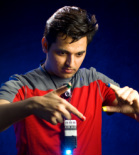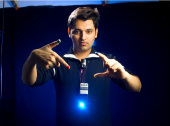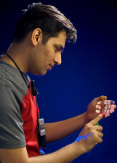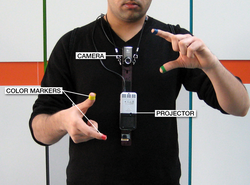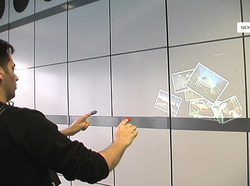Exhibit A: SixthSense Technology
On his website, Pranav Mistry explains that traditionally in societies
today information is confined either on paper or digitally on a screen (Mistry
2010). In his own words; “SixthSense bridges this gap, bringing intangible,
digital information out into the tangible world, and allowing us to interact
with this information via natural hand gestures. SixthSense frees information
from its confines by seamlessly integrating it with reality, and thus making
the entire world your computer,” (Mistry 2010).
SixthSense functions through the combined use of a camera and projector mounted on a pendant worn by the user. Connected to a mobile computing device (such as a smartphone) in the users pocket, the camera is programmed to recognize specific hand gestures made by the user while the projector projects the pertinent information, allowing for walls, tables or any surface to act as the interface (Mistry 2010). Using this system, SixthSense is able to achieve a new level of interaction between the information and the user and their environment, and in doing so translates several functions of digital media and information technology onto this single system. Looking at the broader scope of digital media and devices today,it could be asserted that the nature of new media itself is a progression that advances towards the combination of information and technology and their seamless integration into our lives. The most well known products of this progression (including smartphones, tablets, and laptops) have never extended beyond the archetypal hand held or lap/desk oriented model. In contrast with the present state of digital media and development of devices that are considered ‘new’, SixthSense technology can be considered as new and unique in the way it manages to translate many uses of digital media into a single device that integrates itself more closely with the user and their environment.
McLuhan has described how the consolidation of information in fixed locations, such as the file cabinets in offices, prescribes action on the part of the user of this information. In the case of the filing cabinet, this used to make it necessary for workers to commute from suburb to downtown. Many other forms of media and technology prescribe a range of behaviours upon the user that ultimately determine their effectiveness and how they are used. In the case of most modern digital media devices the interface requires direct contact and forced interaction with the device itself. In reality using these types of devices can take away or distract one from their surroundings and environment; the physical screen acts as the locus where attention and interaction must take place. SixthSense is a way of remediating many uses and applications of smartphones or computers allowing so that it is the device that interacts more with who is wearing it and their environment and not the other way around. In demonstrations for TED and on his website, Mistry has demonstrated the versatile functions of SixthSense. By making simple gestures in front of the pendant camera, the user can open different applications, such as email browsers, email, or world maps for navigation (Mistry 2010). Telephone calls can be made by dialing numbers on a number pad that is projected onto the users hand, and photographs can be taken by the camera by making a framing hand gesture (Mistry 2010). Additionally SixthSense can enhance real world objects that the user may be interacting with; the projector can show video of news stories onto a newspaper, as well as other information (Mistry 2010). Ultimately SixthSense is a large remediation of several combined uses of digital media.
SixthSense functions through the combined use of a camera and projector mounted on a pendant worn by the user. Connected to a mobile computing device (such as a smartphone) in the users pocket, the camera is programmed to recognize specific hand gestures made by the user while the projector projects the pertinent information, allowing for walls, tables or any surface to act as the interface (Mistry 2010). Using this system, SixthSense is able to achieve a new level of interaction between the information and the user and their environment, and in doing so translates several functions of digital media and information technology onto this single system. Looking at the broader scope of digital media and devices today,it could be asserted that the nature of new media itself is a progression that advances towards the combination of information and technology and their seamless integration into our lives. The most well known products of this progression (including smartphones, tablets, and laptops) have never extended beyond the archetypal hand held or lap/desk oriented model. In contrast with the present state of digital media and development of devices that are considered ‘new’, SixthSense technology can be considered as new and unique in the way it manages to translate many uses of digital media into a single device that integrates itself more closely with the user and their environment.
McLuhan has described how the consolidation of information in fixed locations, such as the file cabinets in offices, prescribes action on the part of the user of this information. In the case of the filing cabinet, this used to make it necessary for workers to commute from suburb to downtown. Many other forms of media and technology prescribe a range of behaviours upon the user that ultimately determine their effectiveness and how they are used. In the case of most modern digital media devices the interface requires direct contact and forced interaction with the device itself. In reality using these types of devices can take away or distract one from their surroundings and environment; the physical screen acts as the locus where attention and interaction must take place. SixthSense is a way of remediating many uses and applications of smartphones or computers allowing so that it is the device that interacts more with who is wearing it and their environment and not the other way around. In demonstrations for TED and on his website, Mistry has demonstrated the versatile functions of SixthSense. By making simple gestures in front of the pendant camera, the user can open different applications, such as email browsers, email, or world maps for navigation (Mistry 2010). Telephone calls can be made by dialing numbers on a number pad that is projected onto the users hand, and photographs can be taken by the camera by making a framing hand gesture (Mistry 2010). Additionally SixthSense can enhance real world objects that the user may be interacting with; the projector can show video of news stories onto a newspaper, as well as other information (Mistry 2010). Ultimately SixthSense is a large remediation of several combined uses of digital media.
Jay Bolter and Richard Grusin describe the process of remediation in Remediation: Understanding New Media: “The goal of remediation is to refashion or rehabilitate other media. Furthermore, because all mediations are both real and mediations of the real, remediation can also be understood as a process of reforming reality as well,” (Bolter & Grusin 56). The remediation brought about by SixthSense satisfies another aspect of what Bolter and Grusin discuss in their book, namely immediacy and transparency. In describing transparency and immediacy, the authors use virtual reality as an example, saying that virtual reality should come as close as possible to our daily visual experience (Bolter & Grusin 22). The object of transparency is to try and make the medium go almost unnoticed in our use of it: “a transparent interface would be one that erases itself, so that the user is no longer aware of confronting a medium, but instead stands in an immediate relationship to the contents of that medium,” (Bolter & Grusin 24). It is clear that this is what SixthSense is trying to achieve, by making information accessible through direct use of hand gestures and an interface that adapts to the users environment, which in turn lends to the devices immediacy. Immediacy is supposed to make the interface of any device as natural and intuitive as possible (Bolter & Grusin 23). In this way, SixthSense not only achieves immediacy in itself, but also transforms (or remediates) the immediacy of other print/text based information, by making it possible to pinch and drag real text into the SixthSense or computer screen which enables flow between mediums making it possible to draw from text documents as well as digital information simultaneously (Mistry 2009). Ultimately Mistry is interested in maintaining connection and interaction with the Physical world, while at the same time being able to easily access information.
In Out with the Trash: On the Future of New Media Jonathan Sterne discusses the concept of newness in digital media. In this explains two ways in which newness can be modeled in studying media change. The first model is the newness of a medium with respect to other media, and the second is the so-called ‘state of the art’ in design and function within a given medium (Sterne 147). In this case we are dealing within a single area of digital media: that of digital information devices that includes smartphones, laptops and tablets where the goal is convenience, portability, and effectiveness. Within this realm the newness of these devices and their operating software is considered with primary reference to older ones. Sterne claims that computers have not yet stabilized as a digital medium, which is why even the smallest additional feature can allow something to be considered new (Sterne 148). Sterne also expresses how the current world of digital hardware is now in regular processes of equipment turnover and relies on a system of planned obsolescence in their product lines (Sterne 148,149). However, with these products their developments towards newness seem to be hindered by their physical encumbering’s or trapped behind the screen. From this perspective I can’t help but limit the actual newness of these devices in my understanding of digital media. For example: the newness of the iPad was eagerly awaited and celebrated while in essence it is simply a larger device capable of everything an iPod Touch was capable of, with a few new features. The thing that makes all smartphones, tablets, etc, alike is the screen; a strict physical interface through which the users interact with the information and content within. Removing this static locus of interaction and making it applicable to any surface, as SixthSense does, is definitely a new approach and can be considered beyond the previously established world of digital media access.
Pranav Mistry’s prototype for SixthSense technology represents a potential shift in the way we relate to technology and vice versa. The increased integration of technology in our lives and its ability to engage with people and our environment carries with it post-human or transhumanist ideals, which are based in the idea of better living through increased cooperation of man and technology. However, the transhumanist view carries with it potential for controversy and debate concerning the question of whether or not increased technological integration is really beneficial or if it will prove to have negative consequences. Katherine Hayles discusses issues raised by Norbert Wiener concerning loss of autonomy or liberal subjectivity in the face of our increased use of technology and machines. Wiener is concerned with preserving his humanistic worldview in the face of cybernetics and mechanistic control (Mitchell 01/31/2011). Cybernetics relates to systems of control and communication and their relation to humans and machines. What Wiener is questioning is whether these technological systems are an enhancement of our functions or cause dependence (Mitchell 01/31/2011). He also cautions that the world should be careful as to not allow machines to become the ones in charge by automating decision making processes (Hayles 85). However in the case of SixthSense this worry does not seem as pertinent in light of its goal of keeping individuals connected with their physical world with the device as a way of augmenting it with information. Wieners cautions also make a distinction between good and bad machines. Machines or devices that have become too inflexible or rigid are considered ‘evil’ in that they remove or compromise human flexibility or autonomy (Hayles 105). In contrast with SixthSense, the average desktop computer or even portable devices are far more rigid and demanding in their use by human beings, or as Hayles says they ‘absorb human beings’ and in effect reduce our agency or ability to act freely (Hayles 105). Wiener’s main concern is to “construct the boundaries of the cybernetic machine so that it reinforces rather than threatens the autonomous self,” (Hayles 105). This is an accurate representation of what Mistry has set out to do with SixthSense, in how it looks at information flows in people and their environments as opposed to boundaries between people and machines. It also has the potential to be used to augment the lives of people with hearing or seeing impairments: "The camera can act as a third eye for the blind person, and tell them what it sees. It could be an ear for a deaf person," (Mistry 2009).
In summation, in contrast with previous digital media devices, the SixthSense device is able to translate and remediate old media practices in a unique and new way, and facilitates a more interactive method of combining information technology into everyday life. It also has the potential to augment a fifth sense in the case of deaf or blind people, and ultimately pose a new way of interacting with digital media and prevent us from becoming "machines sitting in front of other machines," (Mistry, TED 2009)
Pranav Mistry’s prototype for SixthSense technology represents a potential shift in the way we relate to technology and vice versa. The increased integration of technology in our lives and its ability to engage with people and our environment carries with it post-human or transhumanist ideals, which are based in the idea of better living through increased cooperation of man and technology. However, the transhumanist view carries with it potential for controversy and debate concerning the question of whether or not increased technological integration is really beneficial or if it will prove to have negative consequences. Katherine Hayles discusses issues raised by Norbert Wiener concerning loss of autonomy or liberal subjectivity in the face of our increased use of technology and machines. Wiener is concerned with preserving his humanistic worldview in the face of cybernetics and mechanistic control (Mitchell 01/31/2011). Cybernetics relates to systems of control and communication and their relation to humans and machines. What Wiener is questioning is whether these technological systems are an enhancement of our functions or cause dependence (Mitchell 01/31/2011). He also cautions that the world should be careful as to not allow machines to become the ones in charge by automating decision making processes (Hayles 85). However in the case of SixthSense this worry does not seem as pertinent in light of its goal of keeping individuals connected with their physical world with the device as a way of augmenting it with information. Wieners cautions also make a distinction between good and bad machines. Machines or devices that have become too inflexible or rigid are considered ‘evil’ in that they remove or compromise human flexibility or autonomy (Hayles 105). In contrast with SixthSense, the average desktop computer or even portable devices are far more rigid and demanding in their use by human beings, or as Hayles says they ‘absorb human beings’ and in effect reduce our agency or ability to act freely (Hayles 105). Wiener’s main concern is to “construct the boundaries of the cybernetic machine so that it reinforces rather than threatens the autonomous self,” (Hayles 105). This is an accurate representation of what Mistry has set out to do with SixthSense, in how it looks at information flows in people and their environments as opposed to boundaries between people and machines. It also has the potential to be used to augment the lives of people with hearing or seeing impairments: "The camera can act as a third eye for the blind person, and tell them what it sees. It could be an ear for a deaf person," (Mistry 2009).
In summation, in contrast with previous digital media devices, the SixthSense device is able to translate and remediate old media practices in a unique and new way, and facilitates a more interactive method of combining information technology into everyday life. It also has the potential to augment a fifth sense in the case of deaf or blind people, and ultimately pose a new way of interacting with digital media and prevent us from becoming "machines sitting in front of other machines," (Mistry, TED 2009)

